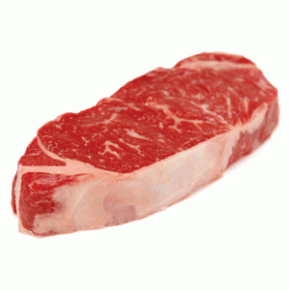Beef is red, right?
As I was doing my regular check of the news and social media this morning, I came across an article on “Pink Slime.” This is has been a viral topic in the news and social media which has been scaring consumers into boycotting beef, even though it is perfectly safe and we have been consuming it for over 20 years with no problems to anyone’s health or safety.
But that’s a whole separate topic… what I was most concerned about was a comment below the article from some reader which read:
“…The next thing that should be looked at is the red dye that is put on meat products either sent to grocery stores or put on by the grocery store to make the meat appear fresh. Real beef steak is not “red” it is grey. It is time to start providing consumers with the “real products” instead of “doctored” products…”
GREY! SERIOUSLY? I was instantly flabbergasted. I couldn’t believe that this person legitimately thought that steak meat was grey.
With all due respect sir, it’s called “red meat” for a reason.
WHY IS BEEF CALLED A “RED” MEAT?
Oxygen is delivered to muscles by the red cells in the blood. One of the proteins in meat, myoglobin, holds the oxygen in the muscle. The amount of myoglobin in animal muscles determines the color of meat. Beef is called a “red” meat because it contains more myoglobin than chicken or fish. Other “red” meats are veal, lamb, and pork.
There is no “dye” which is used to make meat red. They only way it can look grey is if it sits out for a few days, is cooked, or is vacuum sealed which removes the oxygen. But even then, when you re-expose the meat to oxygen, it will return to its red color within a few minutes.
But this blog isn’t even about that “red vs. grey” subject. Most importantly, I’m using this as an example to highlight the serious DISCONNECT that most consumers have with the agricultural industry.
A large percentage of the public doesn’t even know where their food comes from. They just assume that it shows up magically in their grocery store. That is why they get so scared when media or anti-industry groups come out with dramatic or falsified articles regarding food or agriculture.
Being that I am an agricultural communications graduate, this is one of my most passionate topics. As an industry, we need to continue working to increase the public’s awareness of how things are produced. There have been a lot of programs started to help fix this disconnect such as agri-tourism businesses, farm to fork tours and Ag In the Classroom, but we still need to work harder to share our stories.
We need to work to create a clear line of communication and understanding between the public and our industry so that they can be informed to make educated choices about the food they eat.
How do you help share your agricultural story?
Send me a link to your “Ag-Story” and I will put a list together to post in a future blog.
Posted on April 4, 2012, in Agvocating and tagged Ag, Ag in the Classroom, agchat, agriculture, agritouris, agritourism, beef, farm tours, food. Bookmark the permalink. 6 Comments.





Totally agree with you, people are getting so disconnected with where their food comes from its scary. I think in this age of information overload, and instant communication, something as taken for granted as our food is put on the low priority list.
The pop media I feel is to blame. When psuedo celebrities such as the Kardasians take up hours of time on TV and reams of print media how does the “unglamorous” food industry compete. It’s only when a scare mongering media gets a hold of “pink slime” that anyone even pays attention. So what are we agriculturally minded to do? Bring our passions to the forefront and become just as emotional about our food. I have to say that being an Animal Science major I haven’t done a good job myself. I think its something I need to change. Thanks for your posting.
LikeLike
You’re welcome, I’m glad you liked it!
LikeLike
Thanks for this great post! I’m going to share it!
LikeLike
Thank you so much! I checked out your blog as well and love that you are helping relate production agriculture to the consumer! Keep up the great work!
LikeLike
Great post. I also comment about my disappointment in the media and their reporting on Pink Slime on my blog crystalcattle.com. I biggest wish is that consumers would do their own research and get involved with farmers to find out more about where there food comes from and why we use certain agriculture practices.
LikeLike
thank you Crystal! I completely agree!
LikeLike